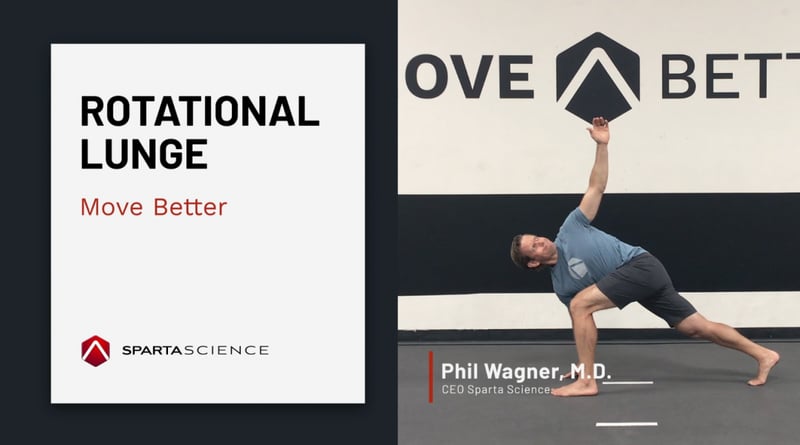
The rotational lunge is a great exercise because it works on the rotational range of motion of the body and that extension period. This exercise can be used in the warm-up or even at the end of a workout every day because it’s stretching out the fascia in this specific plane and movement area.
One of the best things to think about as an outcome is you want to put your chest on your inner thigh. An analogy to think about is you want to fold your body almost like a piece of toast, so you can fit into a toaster. It’s just a good way to think about it. And another way to look at it is if you look at it from the front, that twisting allows you to stay in one thin plane. What this does is you should feel a stretch in what’s called your spiral line, those obliques, the side of your trunk, and even the outer leg, your IT band, your biceps femoris, which is your outer hamstring. It shouldn’t be a stretch that you feel in your pec or your arm. That upper body rotation, that’s really the last part of the sequence and shouldn’t be where it started.
Recommendation is to perform this exercise every day for three reps each.
This movement is really important because life is often linear. We’re seated, so that extension, that rotation range of motion gets shorter as we age and just through our natural everyday activities of sitting. A lot of times it’s called tech neck. You feel this neck pain because your head is pushed forward, which puts a lot of excessive stress on the disc in your back and neck.
Types of activities where you’re at risk is rotation or overhead, particularly throwing, because those hips, that thoracic spine, that upper spine really extends and rotates. And so we start to see things like shoulder impingement because without that extension of the upper back and the hips, there’s less space of the shoulder. That shoulder has to get moved more. And so, when to do this, you can do this every day, three reps, each side, because each rep is at least five seconds to try to push that end range of motion. And to make it harder, you can straighten that front leg in order to put more stress on that spiral line fascia.
Those that need it often have a high explode on our jump scan. They’re stiff, which is great to be able to be quick, but at the same time, that rotation requires a much longer range of motion, which oftentimes is more slack in that ability to transfer force initially to a finish. And that explode really lacks that ability to prolong that force production.
You should feel a stretch in what’s called your spiral line, those obliques, the side of your trunk, and even the outer leg, your IT band, your biceps femoris, which is your outer hamstring. It shouldn’t be a stretch that you feel in your pec or your arm. That upper body rotation, that’s really the last part of the sequence and shouldn’t be where it started.
The best way to do this type of movement is every day for three reps each. Generally, individuals that have a high explode score are the ones that could benefit most from this type of movement.
Regardless of the training day, utilizing the rotational Lunge is a must-add to your warmup routine.